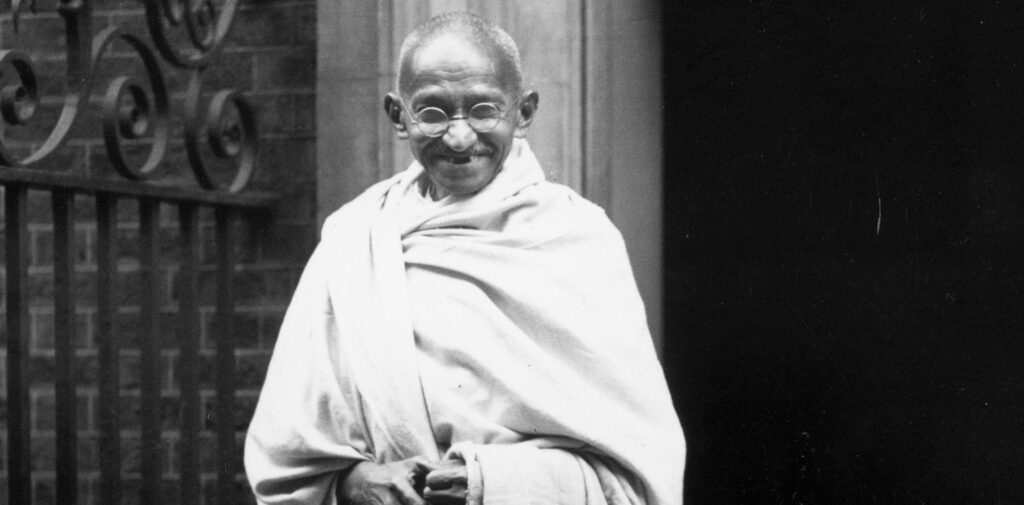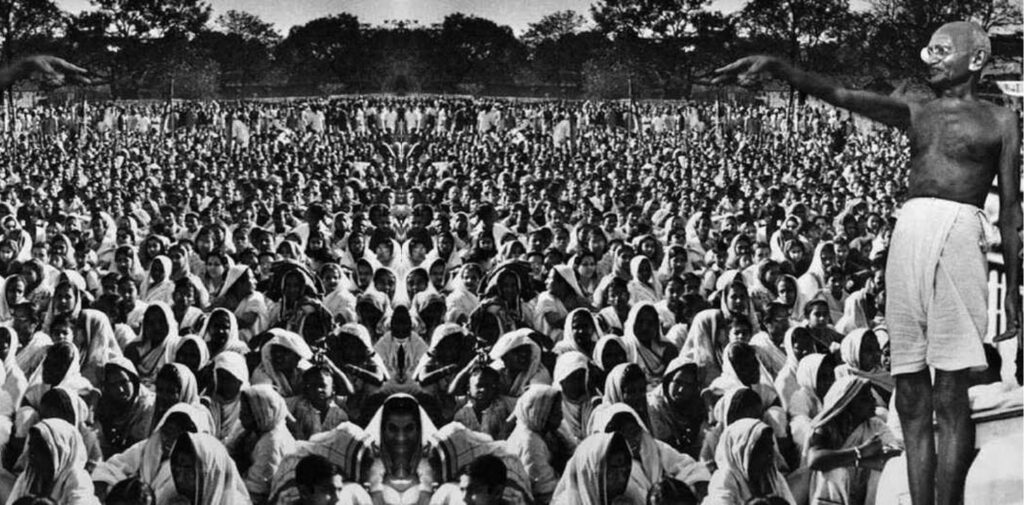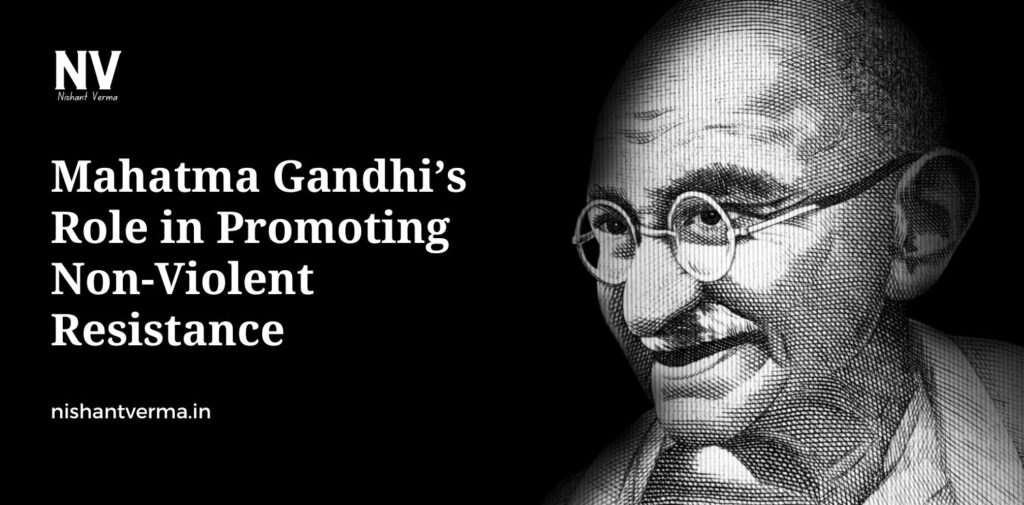Mahatma Gandhi is often regarded as one of the greatest leaders in world history. He is best known for his leadership in India’s struggle for independence from British rule and for his promotion of non-violent resistance as a powerful tool for social and political change. His philosophy of Ahimsa (non-violence) and Satyagraha (truth-force or non-violent resistance) became the cornerstone of his methods and have inspired many global movements for civil rights and social justice.
This article explores Mahatma Gandhi’s role in promoting non-violent resistance, how he applied these principles in India’s fight for freedom, and the lasting impact of his methods on the world.
Gandhi’s Philosophy of Non-Violence and Truth
At the heart of Gandhi’s leadership and methods was his belief in non-violence (Ahimsa) and truth (Satya). Gandhi argued that non-violence is not just the absence of physical harm but a broader attitude of kindness, understanding, and respect for all living beings. For him, non-violence was a way of life—a path to social harmony, personal growth, and collective peace.
Gandhi also believed that truth was the ultimate moral force. He felt that in order to fight for justice, one must be grounded in the truth, which would always lead to victory. His method of Satyagraha was based on the idea that those who uphold truth and resist oppression in a peaceful manner would ultimately triumph, regardless of the violence or force used by the oppressor.
For Gandhi, non-violence was not a passive or weak response to oppression but an active and powerful way of confronting injustice. He believed that non-violent resistance could mobilize millions, inspire global solidarity, and create lasting social change. His vision was to fight for justice, dignity, and freedom without using harmful methods like violence or hatred.

Gandhi’s Early Life and Influences
Gandhi’s ideas about non-violence and resistance did not develop in isolation. His early life experiences and education played a crucial role in shaping his philosophy. Born in 1869 in Porbandar, Gujarat, Gandhi was exposed to a mix of traditional Indian values and Western education. During his time in London, he was influenced by thinkers such as Leo Tolstoy, who believed in the power of non-violence, and Henry David Thoreau, who advocated for civil disobedience.
His experiences in South Africa, where he lived from 1893 to 1914, further shaped his commitment to non-violent resistance. During his time there, Gandhi fought against discriminatory laws imposed on Indians. He coined the term Satyagraha during this period, which meant “truth force” or “soul force.” He organized peaceful protests and encouraged the Indian community to refuse to comply with unjust laws. His success in South Africa was an early demonstration of how non-violent resistance could achieve real social and political change.

Non-Violent Resistance in India’s Struggle for Independence
Gandhi’s leadership in India’s fight for independence was rooted in his belief in non-violence. By applying his methods of Satyagraha, he transformed the Indian struggle into a mass movement. Unlike previous leaders who advocated for armed struggle, Gandhi believed that independence could only be achieved through peaceful means. He wanted to create a movement that would appeal to people of all social backgrounds, regardless of their religion, caste, or gender.
The Champaran and Kheda Satyagrahas (1917-1918)
Gandhi’s first major success in India came in Champaran, Bihar, in 1917. Farmers in this region were being forced to grow indigo for British planters under extremely harsh conditions. Gandhi organized a peaceful movement, urging the farmers to stand up for their rights. He led the Champaran Satyagraha, where thousands of peasants participated in non-violent protests and civil disobedience. Eventually, the British government was forced to address their grievances, marking one of Gandhi’s earliest victories.
The following year, in Kheda, Gujarat, Gandhi led another non-violent struggle against oppressive taxation on farmers who were suffering from crop failures. Gandhi’s peaceful methods brought together people from different parts of society, including farmers, students, and local leaders, and put pressure on the British government to relent. The Kheda Satyagraha succeeded in forcing the British to reduce the taxes, demonstrating the effectiveness of non-violent resistance.
The Non-Cooperation Movement (1920-1922)
One of the most significant events in Gandhi’s fight for Indian independence was the Non-Cooperation Movement of 1920. After the Jallianwala Bagh massacre in 1919, in which British troops killed hundreds of unarmed Indian civilians, Gandhi called for mass non-cooperation with the British government. He urged Indians to boycott British goods, resign from government jobs, and withdraw from British educational institutions.
The Non-Cooperation Movement became a massive national campaign, with millions of Indians participating in protests, strikes, and boycotts. Gandhi believed that by refusing to cooperate with the British, Indians could weaken British control over the country. He emphasized that this movement should be non-violent and that any act of violence would undermine the goals of the struggle.
The movement was initially successful in garnering widespread support, but it came to an abrupt end in 1922 when violence broke out at Chauri Chaura, Uttar Pradesh, where a mob of protestors killed several police officers. Gandhi, deeply committed to his principle of non-violence, called off the movement, even though it was gaining momentum. This decision demonstrated his unwavering commitment to non-violent resistance, even at the cost of short-term political gain.
The Salt March (1930)
Perhaps the most famous example of Gandhi’s non-violent resistance was the Salt March, or Dandi March, of 1930. The British colonial government had imposed a salt tax, which made it illegal for Indians to produce or sell salt independently. In protest, Gandhi embarked on a 240-mile march from Sabarmati Ashram to the coastal village of Dandi in Gujarat, where he would produce salt from the sea, defying British law.
The Salt March was a powerful act of civil disobedience that attracted national and international attention. It demonstrated Gandhi’s ability to mobilize the masses for a common cause and his commitment to peaceful resistance. Thousands of people joined Gandhi along the way, and many more followed his example by producing salt in defiance of British laws. The Salt March marked a turning point in India’s struggle for independence and led to widespread protests across the country.
The Quit India Movement (1942)
In 1942, as World War II raged on, Gandhi launched the Quit India Movement, demanding an immediate end to British rule in India. The movement was peaceful, and Gandhi called for a mass civil disobedience campaign. Though the British arrested many of Gandhi’s followers and banned the movement, the Quit India campaign helped galvanize the nation and strengthen the resolve of the Indian people for independence.

Global Influence of Gandhi’s Non-Violent Resistance
Gandhi’s method of non-violent resistance, or Satyagraha, had a far-reaching impact beyond India. His philosophy inspired numerous global leaders and movements. For example, Martin Luther King Jr., the leader of the civil rights movement in the United States, was greatly influenced by Gandhi’s ideas on non-violence. King used peaceful protests, boycotts, and civil disobedience to challenge racial segregation and discrimination in the U.S.
Similarly, Nelson Mandela and other leaders in South Africa drew from Gandhi’s methods in their fight against apartheid. Gandhi’s emphasis on peaceful resistance became a model for oppressed peoples around the world, showing that non-violence could bring about significant social and political change.
Conclusion: Gandhi’s Lasting Legacy
Mahatma Gandhi’s role in promoting non-violent resistance has left an indelible mark on the world. His methods of non-violence and truth-based resistance not only played a crucial role in India’s struggle for independence but also influenced movements for civil rights and justice across the globe. Gandhi’s belief that social and political change can be achieved through peaceful means continues to inspire millions of people today.
In a world that continues to face issues of inequality, injustice, and violence, Gandhi’s philosophy of Ahimsa and Satyagraha remains a beacon of hope, showing that even in the face of oppression, non-violence can be a powerful and transformative force. Gandhi’s legacy teaches us that the strength of a movement lies not in the force it uses, but in the truth it upholds and the peace it promotes.




